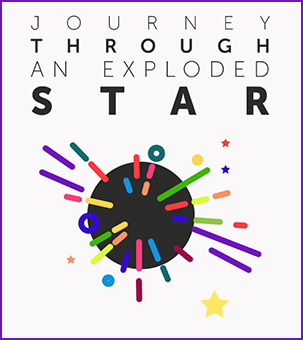Events
CfA Hosts Special Vera Rubin Event with SAWHM, US Mint and Others
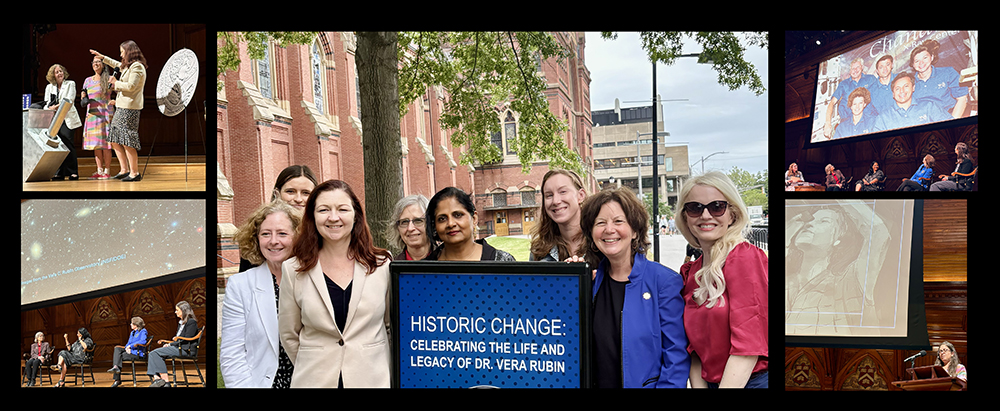
On June 26, 2025, the Center for Astrophysics | Harvard & Smithsonian, and the Harvard Plate Stacks, in partnership with the Smithsonian American Women’s History Museum (SAWHM) and the United States Mint, hosted Historic Change: Celebrating the Life and Legacy of Dr. Vera Rubin at Sanders Theatre in Cambridge, MA. This event honored the pioneering astronomer with the ceremonial release of the new U.S. quarter bearing her image. One of the most moving moments came from Rubin’s granddaughter, Ramona, who offered a heartfelt reflection on her grandmother’s impact as both a scientist and a role model.
Vera Rubin Celebration Town Hall
The Vera Rubin Celebration Town Hall at AAS 246 brought together a crowd of about 200 attendees to honor the scientific legacy and inspirational career of Dr. Vera Rubin. Held at the Dena’ina Civic & Convention Center in Anchorage Alaska during the American Astronomical Society (AAS) meeting, the session overflowed with enthusiastic participants—many sitting on the floor—eager to celebrate the astronomer whose groundbreaking work on galaxy rotation curves provided the first compelling evidence for dark matter.
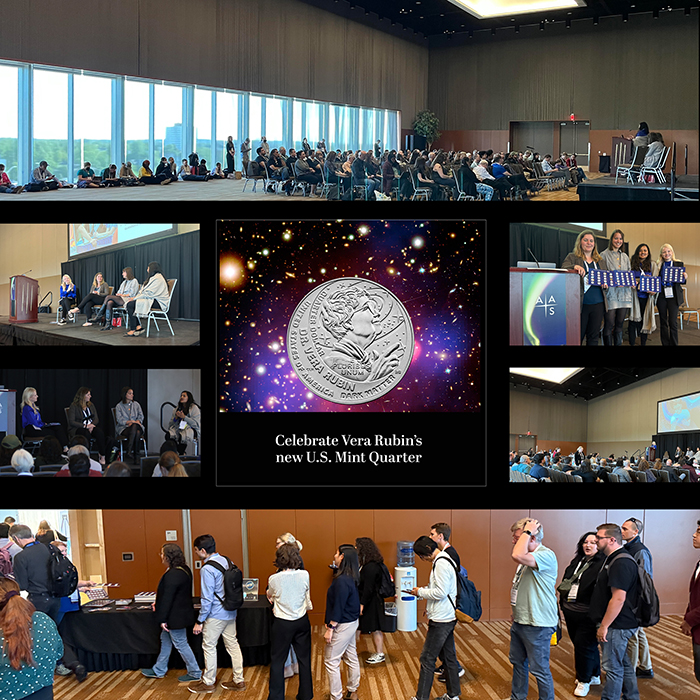
"Journey Through an Exploded Star" Opens
A new way to interact and explore Cassiopeia A, the remains of an exploded star, has launched. The press release below outlines this novel initiative between the Smithsonian Center for Learning and Digital Access and the Chandra X-ray Center. Led by Chandra’s Kimberly Arcand, this project allows you to watch, interact, or learn about this supernova remnant while delving into astrophysics, computer science, and more.
This online interactive version of Cas A (as it’s referred to) is one latest milestone with Chandra. Cas A was the “First Light” image that Chandra observed just weeks after being launched into space in 1999. In the nearly twenty years since, Chandra has repeatedly observed Cas A, revealing new secrets about this object from the neutron star at its center to the elements of life it has expelled.
A decade ago, a team of scientists and image processors came together and created the first-ever three-dimensional model of Cas A. Now, this 3D model enters a new phase with the launching of "Journey Through an Exploded Star"” We hope you will explore with us.
24 Hours of Light
Light is something we experience every day. For most people, "light" refers to what humans can detect with our eyes. It is illumination, what ignites our visual sense, the yin to the yang of dark. However, the type of light humans can detect with our eyes is just a small fraction that exists, and the true nature of light is much more expansive.
In many ways, light behaves like a wave and this is the key to understanding its amazing capabilities. How tightly packed — or far apart — the waves are dictates light's properties. For example, the longer the wave, the less energy the light typically carries, and vice versa. Each type of light has its own "super powers" both in their natural forms and in ways sculpted by science and technology.
Picture a piano keyboard. The popular definition of light would inhabit a few keys around middle C, while the rest of the piano represents the full breadth of light and its many forms. On one end of the piano of light, there are radio waves. As you move up through the octaves, there are other forms of light including microwaves, infrared, "visible" light, ultraviolet, X-rays, and gamma rays.
Black Girls Code and NASA's Chandra Team Up for a Special Event
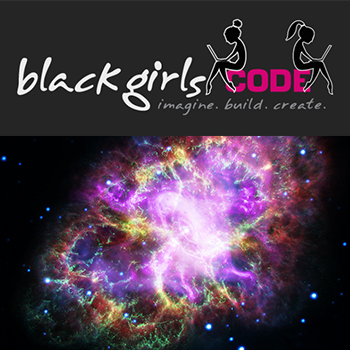
On Saturday, April 14, women and girls will gather in Brooklyn, NY, for a special STEM (science, technology, engineering, and mathematics) event. Black Girls Code, or BGC, is partnering with NASA’s Chandra X-ray Observatory to help girls and young women learn how astronomers and computer scientists use data to create images of our Universe in two and three dimensions.
Following a connected series of activities, the participants (ages 9-13) will explore coding, 3D modeling, Virtual Reality, and more – all while using real data from NASA telescopes currently in space. Special guest speakers will include Andrea Razzaghi, Astrophysics Deputy Director at NASA HQ and Jessica Harris, an astronomer and education program development officer at the National Radio Astronomical Observatory.
This BGC event is the latest in the series of coding outreach programs developed by the Communications and Education group at the Chandra X-ray Center in Cambridge, Mass. The driving force for these efforts is Kimberly Arcand, who brings a computer science background to her role as Chandra’s Visualization lead, and her team of image processors, computer programmers and designers.
Chandra has consistently prioritized developing tools for non-experts to interact with and investigate data from Chandra, one of NASA’s “Great Observatories,” along with the Hubble Space Telescope and the Spitzer Space Telescope.
Chandra Celebrates Dark Matter Day
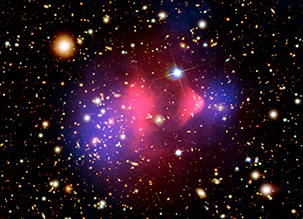
The Bullet Cluster
While October 31st is obviously known best (at least in the United States) as the day to celebrate Halloween, this year it takes on an extra meaning. Scientists and science communicators have designated October 31, 2017 to be "Dark Matter Day".
Dark matter is the mysterious and pervasive substance that constitutes most of the matter in our Universe. Although scientists have made progress in better understanding dark matter, the true nature of this invisible material remains elusive.
NASA’s Chandra X-ray Observatory plays an important role in the search to learn about dark matter. For example, in 2006 Chandra’s observations of the Bullet Cluster (officially known as 1E 0657-56) helped provide direct proof for the existence of dark matter, in a violent merger between two galaxy clusters. More recently, astronomers have used Chandra to test one model for dark matter by studying a collection of galaxy clusters.
400 Students, Educators, and Technology Professionals Attend "Hidden Figures" Event
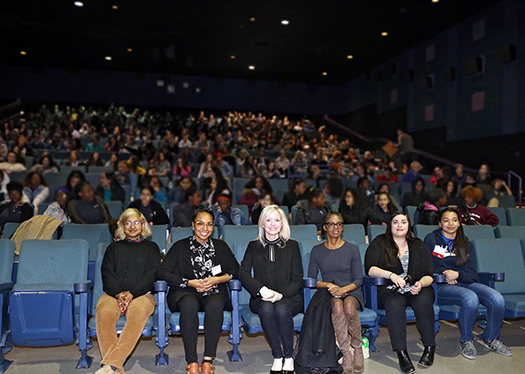
Photo Credit: Tracy Karin Prell
Over 400 female middle and high school students, educators, and technology professionals attended a viewing of Hidden Figures and panel discussion at the Warwick Showcase Cinemas on Friday, March 24, 2017. The event was presented by Tech Collective, Rhode Island's industry association for technology, in partnership with NASA's Chandray X-ray Observatory and Providence P-TECH industry partners. The event included a private screening of the 2017 Oscar winning movie followed by a panel discussion featuring female STEAM professionals in Rhode Island.
Chandra’s "Sweet 16"!
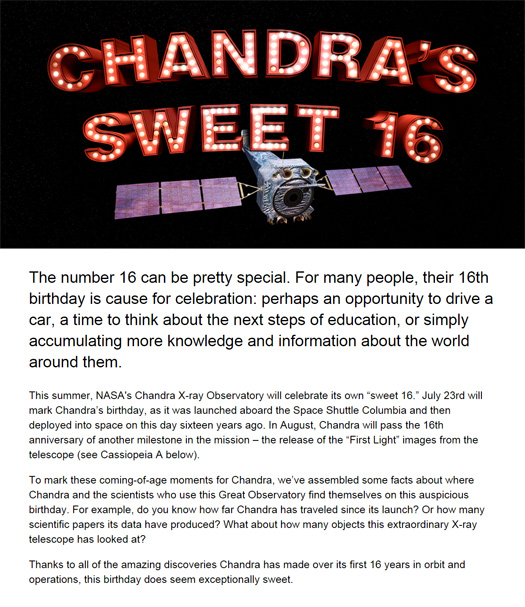
More information at https://chandra.harvard.edu/16th/index.html
Birthdays can be a lot of fun and most teenagers can’t wait to turn sixteen. After all, this birthday often marks new adventures and opportunities (not to mention, maybe a party!)
Today we are celebrating the “sweet 16th” birthday not of a person, but of NASA's Chandra X-ray Observatory. On July 23, 1999, Chandra was launched into space aboard the Space Shuttle Columbia and has been working diligently to explore the high-energy Universe ever since.
Chandra Science on State Street
Hundreds of explorers converged on the campus of Framingham State University in Massachusetts on Saturday, April 25, 2015 to take part in the first annual Science on State Street festival.
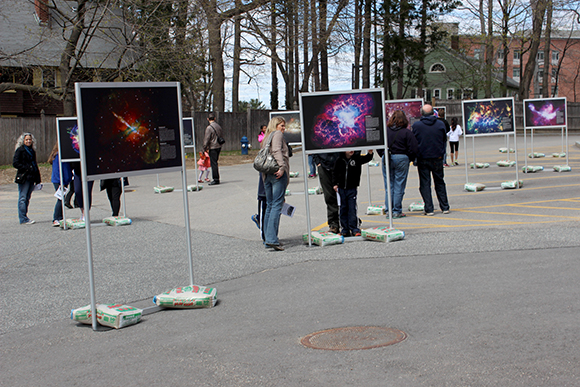
The family-focused event offered up a variety of interactive STEM-themed learning stations addressing aspects of chemistry, astronomy, biology, engineering, robotics and more, arranged outdoors across the University’s shady upper campus. We estimate between 500 and 600 visitors overall to the event.
Thank You, STS-93
A couple of weeks ago, the "15 Years of Science with Chandra" symposium was held in Boston, Mass. It was foremost a chance to bring scientists together who are doing some of the most fascinating research with Chandra on everything from black holes to neutron stars to dark matter.


